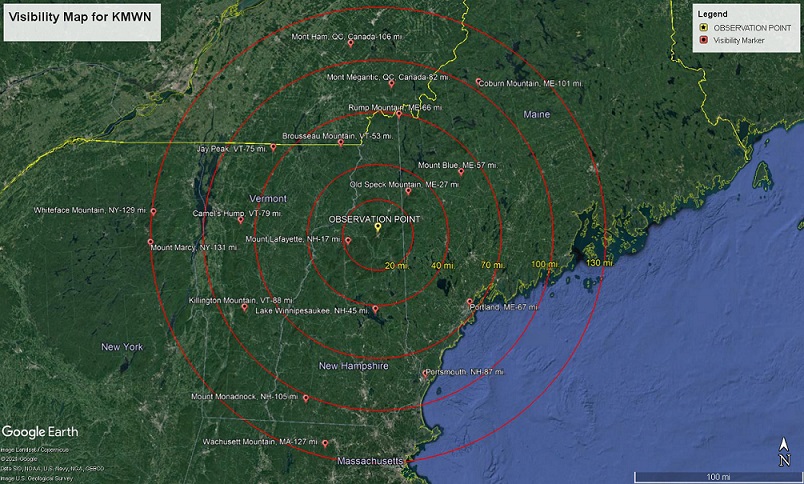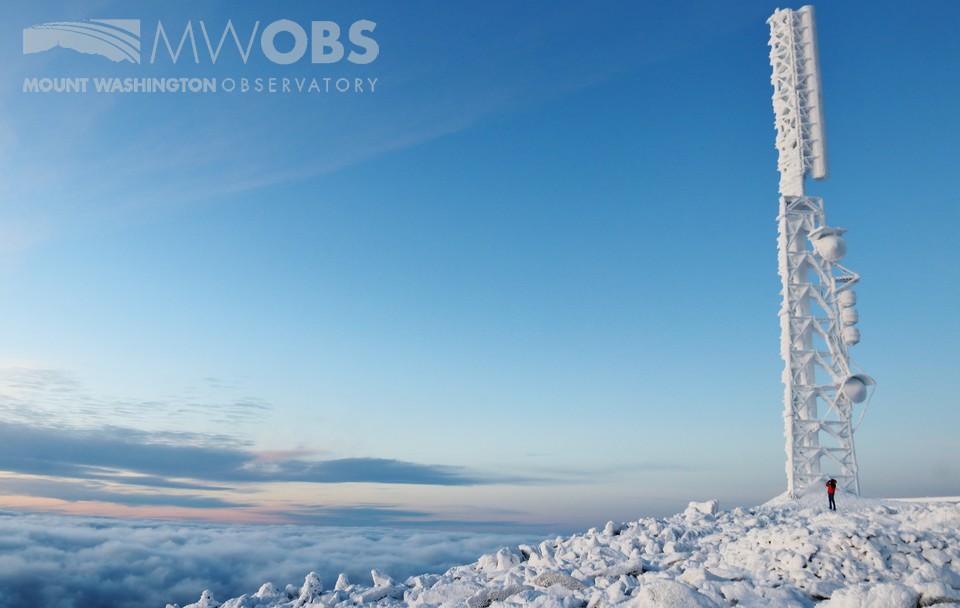Visibility from Summit Appears to be Increasing Over Time
2021-04-21 10:21:46.000 – Charlie Buterbaugh, Development Coordinator
Weather Observers Jay Broccolo and Sam Robinson recently completed an analysis of Mount Washington Observatory’s (MWO) long-term visibility records, studying continuous data collected at the summit’s unique vantage point.
Their exploration grew out of public and staff interest, initially related to the COVID-19 pandemic and its effect on the environment. Back in spring 2020, our staff fielded a number of inquiries asking if the weather observers on the summit were able to see farther than usual due to the global reductions in industry, transportation and overall aerosol emissions. It was a tricky question to answer, because in order to respond with any confidence, one would have to know what “usual” visibility is, and would certainly require a lot of visibility data over time to compare against.
After completing an initial data exploration and analysis of MWO’s long-term visibility records, Broccolo, Robinson, and MWO’s Director of Science & Education Brian Fitzgerald, have just published their project report, “A Data Exploration of Visibility at Mount Washington Observatory (1943-2020), KWMN: Key Findings.”
“Visibility appears to be generally increasing over time on the summit of Mount Washington since continuous observation of visibility began in 1943,” Fitzgerald said.
So how is visibility measured? Our weather observers record something known as “prevailing visibility” at every single hourly observation, both day and night, by determining which known landmarks and distances they can see on the horizon. As the highest point in the Northeast with a treeless summit, Mount Washington’s position allows for an unobstructed view in all directions (provided you’re not in a cloud). The naked-eye view from Mount Washington can reach up to 130 miles to Mt. Marcy in NY, for example, 79 miles to Camel’s Hump in VT, or 67 miles to the Atlantic Ocean off the Maine coast. At night, observers use many of the same natural features plus the lights of known locations to assess visibility.

A map of concentric circles around the summit with visibility markers indicated. The inner-most circle is 20 miles, while the outer-most circle is 130 miles away.
For context, most weather stations that report visibility are at airports with automated instrumentation to help pilots and traffic controllers assess take-off and landing conditions. Visibility at these stations will only report up to 10 miles as the highest value of interest.
“The value of MWO’s long-term visibility records is immense,” Fitzgerald said, adding, “No other record of similar location, length, resolution or quality truly exists, which makes it a tremendous asset for studying the relationships between visibility and air quality over time in Northern New England.”
Broccolo and Robinson examined seasonal and annual average lowest prevailing visibility to explore what long-term trends or anomalies may have been present. The initial analysis appears to show a steady increase in visibility since the 1950s, and then increasing at a higher rate starting in the early 2000s. Whether average visibility was found to be increasing due to the COVID-19 pandemic in 2020 was not easily discernible.
“The next steps would be to analyze the data deeper and corroborate the findings with other measurements,” said Broccolo. “Further statistical analysis is required to show the quality of data. Measurements of air quality affecting particulates at a similar geographic location and elevations or the development of a measuring system at the summit of Mt. Washington would also be of interest in order to compare visibility and air quality.”
An article written by Fitzgerald will appear in the summer 2021 edition of Windswept: The Bulletin of the Mount Washington Observatory, covering additional details about the study’s methodology, results including seasonal visibility variation, and questions for future exploration.
Funding is needed to support additional researchers, research support staff and interns to extend this new-found knowledge and help us investigate possible linkages between visibility, air quality, human health, and our changing climate. Learn more about our current projects and help us continue scientific investigation with a donation to our Spring Appeal.
Contributed by our Weather Observers
Charlie Buterbaugh, Development Coordinator
Team Flags Return for Seek the Peak’s 25th Anniversary
Team Flags Return for Seek the Peak's 25th Anniversary By MWOBS Staff Mount Washington Observatory is looking forward to continuing a much-loved tradition for Seek the Peak’s 25th Anniversary: Team flags. In inviting teams
Meet Summer Interns Zakiya, Max and Maddie
Meet Summer Interns Zakiya, Max and Maddie By MWOBS Staff We are excited to welcome six teammates to the summit of Mount Washington this summer! During their internship, these students and graduates will play
Saying Goodbye to the Summit
Saying Goodbye to the Summit By Alexis George After an extraordinary last three years working as a Weather Observer and Meteorologist, I am excited to pursue a different career. As sad I as am





